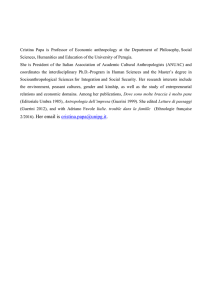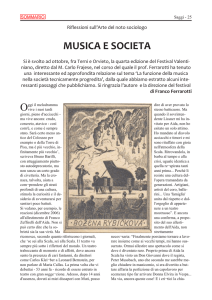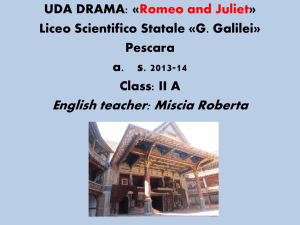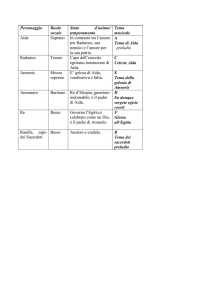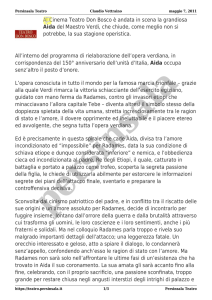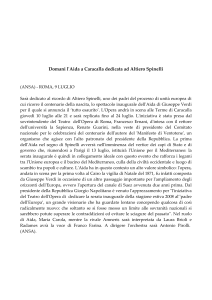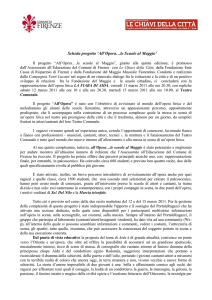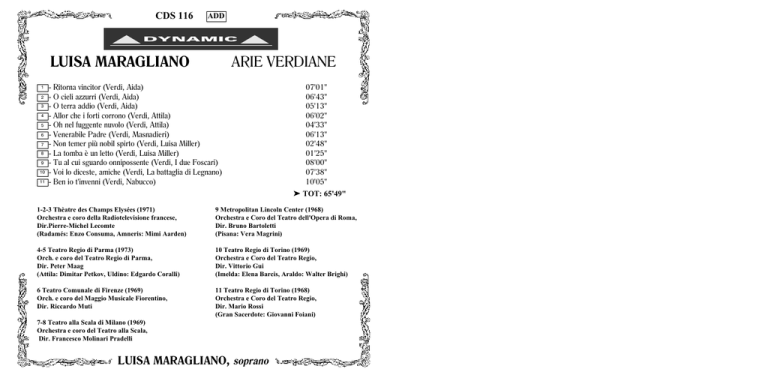
CDS 116
ADD
DYNAMIC
LUISA MARAGLIANO
1
2
3
4
5
6
7
8
9
10
11
ARIE VERDIANE
- Ritorna vincitor (Verdi, Aida)
- O cieli azzurri (Verdi, Aida)
- O terra addio (Verdi, Aida)
- Allor che i forti corrono (Verdi, Attila)
- Oh nel fuggente nuvolo (Verdi, Attila)
- Venerabile Padre (Verdi, Masnadieri)
- Non temer più nobil spirto (Verdi, Luisa Miller)
- La tomba è un letto (Verdi, Luisa Miller)
- Tu al cui sguardo onnipossente (Verdi, I due Foscari)
- Voi lo diceste, amiche (Verdi, La battaglia di Legnano)
- Ben io t'invenni (Verdi, Nabucco)
07'01"
06'43"
05'13"
06'02"
04'33"
06'13"
02'48"
01'25"
08'00"
07'38"
10'05"
➤ TOT: 65'49"
1-2-3 Thèatre des Champs Elysées (1971)
Orchestra e coro della Radiotelevisione francese,
Dir.Pierre-Michel Lecomte
(Radamés: Enzo Consuma, Amneris: Mimi Aarden)
9 Metropolitan Lincoln Center (1968)
Orchestra e Coro del Teatro dell'Opera di Roma,
Dir. Bruno Bartoletti
(Pisana: Vera Magrini)
4-5 Teatro Regio di Parma (1973)
Orch. e coro del Teatro Regio di Parma,
Dir. Peter Maag
(Attila: Dimitar Petkov, Uldino: Edgardo Coralli)
10 Teatro Regio di Torino (1969)
Orchestra e Coro del Teatro Regio,
Dir. Vittorio Gui
(Imelda: Elena Barcis, Araldo: Walter Brighi)
6 Teatro Comunale di Firenze (1969)
Orch. e coro del Maggio Musicale Fiorentino,
Dir. Riccardo Muti
11 Teatro Regio di Torino (1968)
Orchestra e Coro del Teatro Regio,
Dir. Mario Rossi
(Gran Sacerdote: Giovanni Foiani)
7-8 Teatro alla Scala di Milano (1969)
Orchestra e coro del Teatro alla Scala,
Dir. Francesco Molinari Pradelli
LUISA MARAGLIANO, soprano
a storia di Luisa Maragliano, uno dei
soprani più versatili e popolari del ventennio compreso tra il 1959 e il 1979,
in Italia e all'estero, sembra scritta, anziché dal destino, da uno sceneggiatore per un film musicale.
Nata a Genova, si avvicina al melodramma del tutto
casualmente, con un ingresso di favore procurato da
un cugino che é corista del Teatro Comunale
dell'Opera.
E la passione per il canto si accende e divampa
subito, anche se poi con altrettanta rapidità languirà, tra gli immancabili disinganni di cui é solitamente prodigo l'insegnamento privato.
Dotata di una bella voce naturale, di soprano lirico,
di musicalità, e armata del coraggio irriducibile che
nasce dalla vocazione, ella si presenta comunque ad
una audizione nel vecchio Carlo Felice. Siamo nel
1955 e il glorioso Teatro ottocentesco, privo ormai
degli ori e degli stucchi, é rabberciato, dopo le devastazioni belliche: il tetto é posticcio e la sola platea é
agibile; le cinque file di palchi e il loggione,
ischeletriti dal fuoco delle bombe incendiarie, sono
nascosti da tendaggi scarlatti. Ma il p a l coscenico é intatto e in locandina c'é
nientemeno che il "Parsifal".
Il Maestro sostituto Tristan Illersberg deve scegliere
le Fanciulle Fiore, per il giardino incantato del secondo atto: e Luisa, per l'avvenenza oltre che per la rarità
della voce, appare subito, all'esaminatore, ideale
per sedurre il t e n o r e t e d e s c o G u n t h e r
T r e p t o w , c h e é i l protagonista dell'opera di
Wagner. Ma a cadere vittima del fascino di
questa bella,
slanciata, sorridente fanciulla non é soltanto il
leggendario padre di Lohengrin: Illersberg
stesso, a sua volta conquistato, prima si incarica
di insegnare la parte a Luisa, consentendole così
di debuttare giovanissima nella prestigiosa sala del
Barabino, poi conduce all'altare l'allieva e quindi per
due anni, tenendola prudentemente lontana dalle
scene, ne cura la preparazione vocale e il saggio
avvio di carriera, assegnandole un cauto repertorio,
quello del soprano lirico puro.
Dopo le prime lusinghiere Mimì e Cio-Cio-San, a
Berna e a Basilea, dunque, seguite da un salutare
tirocinio nella provincia, ecco l'artista pronta, nel
1959, al naturale, predestinato dai mezzi, passaggio ai ruoli di lirico spinto e al fausto debutto quindi
all'Arena di Verona, come Leonora ne "La forza del
destino", sotto la direzione di Antonino Votto e in una
compagnia che comprende Bergonzi e Protti. Il successo é tale da farla confermare per l'anno successivo,
nella stessa Arena, con la tunica di Aida, sotto la
guida di Gavazzeni e ancora al fianco di Bergonzi,
con la Simionato e Giangiacomo Guelfi. All'Arena
la Maragliano tornerà con una frequenza difficilmente eguagliabile fino al 1972 (ancora "Aida",
diretta da De Fabritiis, con Corelli e la Cortez),
cantandovi anche come applauditissima Abigaille.
Grazie all'evoluzione vocale e interpretativa, allo
studio assiduo, sempre sotto la guida preziosa del
compagno della sua vita, in un'epoca nella quale le sue
stesse parti erano sostenute, oltreché dalla Callas,
anche dalla Cerquetti, dalla Stella, dalla Suliotis,
etc., Luisa si afferma definitivamente come uno dei
rari soprani drammatici di agilità. E ottiene trionfi e
conferme lusinghiere nei maggiori teatri europei e
di oltre Oceano.
Alla Scala arriva nel 1965 ("Mosé" con Ghiaurov e
poi "Aida"), vi torna nel 1968 come Luisa Miller
con Tucker e come Leonora nel "Trovatore" con
Bergonzi, Cappuccilli e la Cossotto, direzione di
Gavazzeni e regìa di Visconti; é nuovamente
Leonora in un "Trovatore" con Cappuccilli nel
L
4
1971, poi Odabella nell'"Attila" del '1975 con
Martinucci e, ancora, Luisa Miller nel 1976 con
Garaventa e la direzione di Gavazzeni.
A Vienna intanto é Violetta Valery alla Volksoper
nel 1960 e alla Staatsoper é Aida, Matilde nel
"Tell" ed Elisabetta nel "Don Carlo", con Siepi.
Nel 1967 é chiamata oltre Atlantico. E' alla Lyric
Opera di Chicago e canta nel "Ballo in maschera";
nello stesso teatro nordamericano torna l'anno
dopo, come Manon Lescaut, e nel 1969, con ben
tre recite della stessa opera in soli quattro giorni,
sostituendo la Tebaldi al fianco di Domingo, con la
direzione di Bartoletti, . Col medesimo direttore,
nello stesso anno, é Lucrezia Contarini ne "I due
Foscari" al Metropolitan di New York, con Cioni e
Zanasi; e poi, volando in Sud America, é Luisa
Miller al Colon di Buenos Aires con MacNeil, Labò
e Rossi-Lemeni. La sua Aida é intanto osannata a
Monaco di Baviera (1970), a Dublino (1963), a
Parigi ai Champ Elisée (1971).
Al Covent Garden di Londra canta come
Desdemona nel 1960. Poi, ancora, dividendosi tra
i grandi teatri italiani e quelli oltre Oceano, é a Rio
de Janeiro ("Nabucco" con Giangiacomo Guelfi nel
1968), San Paolo in Brasile, Caracas, Filadelfia,
Miami. In Europa é acclamata nel suo repertorio a
Belgrado in Yugoslavia, ad Amburgo, Berlino,
Francoforte, Mannheim e Augsburg in Germania,
inoltre ad Anversa, Bordeaux, Bruxelles,
Francoforte, Edimburgo e Madrid.
Ma i personaggi più celebri del suo repertorio, che
comprende ben 50 opere, dal "Giulio Cesare" di
Haendel al "Doktor Faust" di Busoni, conquistano
anche i pubblici di moltissimi altri grandi teatri: a
Tosca (Barcellona, 1961 con Corelli), si affiancano, nelle più memorabili serate, le Amelie del
"Simon Boccanegra" (Opera di Roma, 1969), e
quelle del "Ballo in maschera" (San Carlo di
Napoli, 1972) , le Elvire di "Ernani", le Leonore
del "Trovatore" (Montecarlo 1962, con Corelli) e
quelle de "La forza del destino" (Bologna 1959,
con Labò).E poi le molte Maddalene di Coigny
(Viareggio 1961, con Di Stefano). E altri titoli
meno consueti: "Suor Angelica" a Buenos Aires nel
1963, "Principe Igor" al Massimo Bellini di Catania
nel 1958 con Taddei e Arié, "Francesca da
Rimini" nel 1970 a Trieste, "Tabarro" nel 1971 a
Lisbona.
A Firenze, nel 1969, con Muti sul podio, é Amalia
ne "I Masnadieri". Nello stesso anno, a Torino,
confermando la sua predilezione per le opere del
giovane Verdi, é anche Lida ne "La battaglia di
Legnano", diretta da Gui.
Una grossa fetta della fama della Maragliano é
comunque legata, a riprova della saldezza dei suoi
mezzi vocali, dell'incisività dell'accento e del considerevole volume, alle presenze negli spettacoli
all'aperto. Un capitolo importante, questo, quasi
una specializzazione.
Oltre all'Arena di Verona, dove l'artista ha regnato dal
1959 al 1972, come abbiamo visto, con "Aida",
"Nabucco" e "Forza del destino", ecco le Terme
romane di Caracalla, con ben sette edizioni di
"Aida", dal 1962 al 1973, con i Radames di
Limarilli, Ottolini, Casellato-Lamberti, Prevedi e
Mori; lo Sferisterio di Macerata dal 1969 al 1971
ancora con "Aida", "Chenier" e "Bohème" (quest'ultima opera con Corelli); il Teatro Romano di
Benevento ancora con "Aida", "Forza del destino" e
"Ballo in maschera" dal 1974 al 1976; il Teatro
Grande di Pompei col "Giulio Cesare" di Haendel
diretto da Kuhn nel 1975; l'Arena di Nizza con "Il
Trovatore" (1956, dirige Patané, con Filippeschi
ed Elena Nicolai); poi l'Anfiteatro di Merida in
5
Spagna nel 1966 nuovamente col "Giulio Cesare";
Busseto con "Forza del destino" al fianco di Bergonzi
nel 1961; l'Arena Flegrea di Napoli l'anno dopo con
un'"Aida" diretta da Previtali; infine "Cavalleria rusticana" in Piazza Duomo a Lecce e un'"Aida" al
Castello di San Giusto a Trieste.
I continui impegni in giro per il mondo, e il vecchio
detto latino "nemo propheta in patria", curiosamente hanno impedito a Luisa di cantare più spesso nella sua città natale: "Butterfly" e "Liliadeh" di
Quinteri al Politeama Genovese e "Traviata" al
Teatro Augustus nel 1957; e "Un ballo in
maschera" al Teatro Margherita nel 1972, con
Cappuccilli, direttore De Fabritiis. Tutto qui.
Nella seconda metà degli anni Settanta, al colmo
del successo e della popolarità, l'uomo che ha forgiato l'artista, Tristan Illersberg, si ammala gravemente. Per dedicarsi interamente a lui, per assisterlo e curarlo, Luisa si ritira virtualmente dalle
scene: nelle brevi parentesi, quelle degli illusori,
momentanei miglioramenti dell'infermo, rispondendo alle insistenti proposte dei Teatri, torna
occasionalmente al
teatro. Al Luglio Musicale Trapanese del 1981, per
esempio, affronta per la prima volta e con successo
il personaggio di Fedora. La voce é intatta, ma la
carriera é ormai segnata, spezzata.
Nel 1976 l'artista insegna al Conservatorio di Lecce
e alla città pugliese, anche per gratitudine, nel 1986
riserva il privilegio di applaudirla per l'ultima volta,
in un addio ufficiale al teatro, con "Chenier".
Ha alle sue spalle, ritirandosi ancora giovane, con
gli innumerevoli riconoscimenti, tra i quali la
"Maschera d'argento" 1968 e una Targa di Parma,
roccaforte del Cigno di Busseto, "alla più pura e
generosa voce verdiana", oltre un migliaio di recite
.
Per alcuni anni, anche dopo la morte del coniuge, Luisa
si rifiuta di cantare. Solo recentemente, incoraggiata da amici e ammiratori fedeli, che non l'hanno mai
dimenticata, é tornata a dare dei concerti.
Questo CD si propone dunque, non soltanto di
ricordare l'affascinante signora del canto che fu
Luisa Maragliano, ma di riparare anche ad una
imperdonabile negligenza del mondo musicale,
quello delle Case discografiche, che mai si ricordarono del soprano genovese, nemmeno negli anni
della massima gloria.
Le pagine qui scelte, tutte verdiane, un omaggio
dunque al più amato dei suoi compositori, sono
pertanto tratte sempre da registrazioni dal vivo.
Malgrado le piccole imperfezioni tecniche,
inevitabili nelle registrazioni Live, si colgono perfettamente i pregi della voce e le virtù, il talento della
cantante e dell'interprete. Voce di bel metallo, puro
e levigato, smagliante nel registro acuto, che conserva intatti i suoi armonici anche nel mezzoforte e
nei pianissimi. Voce tipicamente verdiana, dal vibrato stretto, che non intacca ma anzi esalta la compattezza del suono a tutte le altezze e in ogni
gradazione dinamica. Anche l'accento, incisivo,
energico ma sempre pronto a flettersi nei momenti
patetici, é inconfondibilmente verdiano. Pur se
assoggettata ovviamente allo stile e ai gusti degli
anni Sessanta, nei quali si privilegiavano certamente le
ragioni dell'espressione, rispetto alle regole belcantistiche, questa voce evidenzia un eccellente legato,
adesione alle acciaccature, alle appoggiature e a
tutti gli altri
abbellimenti.
La prima ottava si scalda di inflessioni ed espansioni di petto, che conferiscono al canto sensualità,
emotività ed eloquenza. La Maragliano, inoltre, si fa
apprezzare in questi documenti, registrati tutti tra
6
il 1968 e il 1973, quindi nel periodo della piena
maturità artistica,
per le vibrazioni accese, frutto del forte
temperamento, la dialettica e l'accento mordente, le
ampie risonanze di petto, ma anche per la disposizione al canto legato, modulato; e poi per la
nobiltà dell'accento e il bagaglio tecnico, quello del
soprano drammatico di classe.
Tre pagine sono tratte da "Aida". La prima si apre
col recitativo "Ritorna vincitor!" , in cui si apprezzano nobiltà e fierezza di fraseggio, nonché i lampeggianti sol acuti di "struggete le squadre dei nostri oppressor". E subito dopo il folgorante si bemolle
acuto in fortissimo di "Ah! sventurata! che dissi!" E
poi certi la bemolle acuti, luminosi, che precedono
le incursioni sotto il rigo, cupe, dense e duttili ("da
più crudeli angosce un core affranto"); il t e n e r o
ritorno ai "sacri nomi di padre, d'amante",
lo staccato-legato accentato, che richiama al dovere
la figlia di un Re; fino al cantabile estremo, al dolcissimo "Numi, pietà del mio soffrir", che presenta
soavi la bemolle, l'ultimo dei quali privo di portamento, ad attacco scoperto, fino al melisma finale sotto
il rigo, e al morendo in ""pp" della risoluzione.
La seconda scena, quella del Nilo al terzo atto, si
apre con l'intenso, drammatico recitativo "Qui
Radames verrà, che vorra dirmi ?". I suoni di petto
sono ricchi, pieni, fieri: con un'Aida così regale e
densa in basso ("e pace forse oblio", "mai più ti rivedrò") le Amneris dell'epoca dovevano avere certamente vita difficile.
Il cantabile "O cieli azzurri" é cantato col giusto
abbandono, ben legato, anche se forse risulta
meno dolce di come siamo abituati ad ascoltare
dalle varie Aide in miniatura, soprani lirici puri
camuffati da lirico-spinti, dei nostri giorni. Le frasi
in staccato-legato sono fluide, rispettati i segni
d'espressione, i crescendo, i "f" e i "pp" ma senza
sdilinquimenti, questi ultimi, anzi condotti con moduli fieri, nobili, energici.
L'ascesa al do acutissimo, verso la fine dell'aria, muove da
un tenero pianissimo e cresce omogenea, senza perdere
un solo armonico; e pur non osservando l'indicazione temeraria, "dolce", scritta dal compositore,
conclude bene, risolvendo, questa volta osservando la
raccomandazione di "smorzando", su un la naturale
acuto soavissimo e tenuto impeccabilmente, che emana
come una sua luce propria, intrisa di mestizia, per
l'addio alla patria diletta.
L'ultima pagina dell'opera é quella della morte, "O
terra addio", costellata di due e tre volte piano,
morendo, con frasi legate,
pormenti levigati, e tre dolcissimi si bemolle acuti
quasi soprannaturali, sostanziati piuttosto di trasumanante rassegnazione che di energia sonora.
Il secondo personaggio della galleria di eroine verdiane, dopo Aida, é quello di Odabella. Da "Attila",
infatti, possiamo ascoltare l'impetuosa cavatina,
scena III del Prologo, "Allor che i forti corrono",
caratterizzata dallo slancio verticale, e seguita dalla
incisiva cabaletta "Da te questo or m'é concesso".
Segue, dalla stessa opera, scena I del primo atto, il
cantabile "Oh! nel fuggente nuvolo", un Andantino
vario, articolato, che presenta anche trilli e un do
acutissimo, seguito da una scala cromatica discendente.
E' il turno poi di Amalia, eroina de "I Masnadieri",
che dalla scena VI del primo atto propone il recitativo "Venerabile, o padre, é il tuo sembiante", che
precede l'aria "Lo sguardo avea degli angeli", la quale
presenta fiorettature, trilli, picchettati e una cadenza
finale con scala
ascendente, che la Maragliano conclude con una
bellissima nota tenuta a mezzavoce.
7
Due sono invece i momenti che ricordano la Luisa
Miller dell'artista genovese. "Non temer: più nobil
spirto", che introduce l'aria "Lo vidi e 'l primo palpito", scena II del primo atto, nello stile staccato,
col suo da capo e belle note picchettate, e, dalla
scena II del terzo atto, il breve Andantino "La
tomba é un letto sparso di fiori".
La Lucrezia Contarini de "I due Foscari" la possiamo
apprezzare nella cavatina del primo atto, l'Andante
maestoso "Tu al cui sguardo onnipossente", per la fluida
vocalizzazione della sezione finale, che si addice ad
una preghiera, il la naturale acuto e tenuto che lega
la prima alla seconda strofa. E poi lo stringendo che conduce all'Allegro moderato "O patrizi, tremate,
l'Eterno".
La Lida de "La battaglia di Legnano", invece, si
impone, nella scena IV del primo atto, per il recitativo "Voi lo diceste, amiche, amo la patria", al quale
segue la sensibile cavatina "Quante volte come un
dono"; la scena procede, verticalizzandosi nel registro acuto, con Marcovaldo e Imelda ("Ciel! chi
mai?") e approda alla cabaletta scattante, fortemente
ritmata, in staccato, "A frenarti, o cor, nel petto".
Chiude l'ascolto retrospettivo di questa artista, che
solo a causa di vicissitudini private,
all'insegna di un lungo calvario di dolore e di silenziosa
dedizione, che peraltro le fanno anche più onore di
quanto potesse derivarne alla sua arte in teatro, la
grande scena di Abigaille all'inizio del secondo atto
di "Nabucco".
Il recitativo "Ben io t'invenni, o fatal scritto" é incisivo, aggressivo, e si sviluppa con grande sicurezza
su ampi intervalli di sbalzo, bruschi scarti di registro, con una forte accentazione; segue il cantabile
"Anch'io dischiuso un giorno", pagina improntata
per contrasto a dolce lirismo, legatissima, con varietà di fraseggio e liquide volatine; la cabaletta,
"Salgo già del trono aurato", infine, pur priva del da
capo, coinquista per l'impeto, la veemenza del
declamato di forza, la selvaggia violenza delle quartine di semicrome e la saldezza del do acutissimo
finale.
Guido Tartoni
8
Manon Lescaut (1968) - Chicago - Lyric Opera House
Gianandrea Gavazzeni
Nabucco (1962) - Verona - Arena
Luisa Maragliano
-
Traviata (1961) - Philadelphia Opera House
Giangiacomo Guelfi
Suor Angelica (1963) - Buenos Aires - Teatro Colon
Trovatore (1964) - Firenze - Teatro Comunale
Tosca (1972) - Roma - Teatro dell'Opera
he story of Luisa Maragliano, one of the
most versatile and popular sopranos
both in Italy and abroad in the twenty
years from 1959 to 1979, seems almost to be written by a scriptwriter for a musical rather than by
destiny.
Born in Genoa, she came to opera quite by chance,
when she was given a complementary ticket by a
cousin in the choir of the Comunal Opera Theatre.
Her passion for singing was kindled and blazed immediately, even though later just as rapidly it weakened,
among the inevitable disenchantments which accompany private lessons.
Blessed with a beautiful natural operatic soprano
voice, with musicality and armed with a courage born
from vocation she auditioned at the old Carlo Felice
Theatre. This was in 1955, and the glorious nineteenth century theatre, by now without/lacking* its
gold and plasterwork*, was patched up after the
devestation of the war. The roof was temporary and
only the stalls could be used; the five rows of boxes
and "the gods" reduced to charred ruins by the fire
from the incendiary bombs, were hidden by scarlet curtains.
But the stage was intact and on the theatre posters
there was no less than "Parsifal".
The substitute conductor Tristan Illersberg had to
choose the Flower Maidens for the enchanted garden
in the second act, and Luisa, for her charm as well as
for the rare quality of her voice, was immediately
deemed by the examiner to be the perfect choice to
seduce the german tenor Gunther Treptow who was
the star of Wagner's opera. But it was not only the
legendary father of Lohengrin who was to fall victim to this
beautiful, slender, smiling girl. Illersberg, conquered in
his turn, first took it upon himself to teach her the part
of Luisa, thus allowing her to make her debut while
very young in the prestigious sala del Barbarino, and
then, after marrying his pupil, he wisely kept her away
from the stage for two years while he guided her vocal
training and the prudent beginning of her career, giving her a safe repertoire, that of a pure operatic soprano.
After the first gratifying roles of Mimì and
Cio-Cio-San at Bern and Basle, then, followed by a
useful training in the provinces, the artist was quite
ready for the natural move, predestined for mezzo
sopranos, to more challenging operatic roles and to
the auspicous debut at the Verona Arena as Leonora
in "La forza del destino", directed by Antonino Votto
with a cast which included Bergonzi and Protti.
The success of this debut was such as to ensure her a
place for the following year, again in the Arena, in the
tunic of Aida, directed by Gavezzeni and again alongside Bergonzi and with Simionato and Gianfranco
Guelfi. Maragliano was to return to the Arena with an
almost unsurpassed frequency until 1972 (once again
as "Aida" directed by De Fabritiis, with Corelli and
Cortez), and also performing the part of Abigaille
there to great aclaim.
Thanks to her development both as singer and interpreter, and to her diligent study, as ever with the
precious guidance of her lifelong
companion at a time when these same parts were
being sung, as well as by Callas, by Cerquetti, Stella,
Suliotis etc., Luisa made a name for herself as one of
the rare dramatic sopranos possessing agility.
And she won success and gratifying acclaim in the
main European theatres and overseas. She arrived at
"La Scala" in 1965 ("Moses" with Ghiaurov and then
"Aida"), and returned in 1968 as Luisa Miller and in
the "Trovatore" with Bergonzi, Cappuccilli and
Cossotto, conducted by Gavazzeni and directed by
Visconti; and again as Leonora in a "Trovatore" with
T
13
Cappuccilli in 1971, then Odabella in a 1975 "Attila"
with Martinucci and, once more as Luisa Miller in
1976 with Garaventa conducted by Gavezzeni. At
Vienna in the meantime, she sang Violetta Valery at
the Volksoper in 1960 and "Aida", Matilde in "Tell"
and Elisabetta in "Don Carlo" with Siepi at the
Staatsoper.
In 1967 she was called to America. She sang in the
"Ballo in maschera" at the Lyric Opera in Chicago: she
returned to the same North American theatre in the
following year, as Manon Lescaut, and in 1969, with a
three full performances of the same work in only four
days, standing in for Tebaldi alongside Domingo, and
conducted by Bartoletti. With the same conductor and
in the same year she was Lucrezia Contarini in "I due
Foscari" at the
Metropolitan in New York, with Cioni and Zanasi: and
then, flying to South America, she was Luisa Miller at
the Colon in Buenos Aires with MacNiel, Labò and
Rossi-Lemeni. Her Aida was also praised at Munich in
Bavaria (1970), in Dublin (1963) and in Paris at the
Champ Elisée (1971). She sang as Desdemona at
Covent Garden in London in 1960. Then, once more,
dividing her time between the great Italian
theatres and those across the Atlantic, she was in Rio
di Janiero ("Nabucco" with Giangiacomo Guelfi in
1968), San Paulo in Brazil, Caracas, Philadelphia,
and Miami.
In Europe she her repertoire was highly acclaimed in
Belgrade in Yugoslavia, in Hamburg, Berlin, Frankfurt,
Mannheim and Augsburg in Gerrmany, as well as in
Antwerp, Bordeaux, Brussels, Frankfurt, Edinnburgh
and Madrid.But the most celebrated characters in her
repertoire, which included some fifty works, from
"Julius Caesar" by Haendel to "Doktor Faust" by
Busoni, captivated the public in many other important
theatres: along with Tosca (Barcelona, 1961 with
Corelli) the most memorable evenings were those of the
Amelias of "Simon Boccanegra" (the Rome Opera,
1969), of the "Ballo in maschera" (the San Carlo in
Naples, 1972), the Elviras of "Ernani", the Leonoras
of the "Trovatore" (Monte Carlo 1962, with Corelli)
and of "La forza del Destino" (Bologna 1959, with
Labò). And then the many performances of Maddalene
di Coigny (Viareggio 1961, with Di Stefano). There
were also more unusual works: "Sister Angelica" in
Buenos Aires in 1963, "Prince Igor" at the Massimo
Bellini theatre in Catania in 1958 with Taddei and
Arié, "Francesca da Rimini" in 1970 at Trieste and
"Tabarro" in 1971 in Lisbon.
Maragliano was Amalia in "I Masnadieri" in Florence
in 1969 with Muti on the podium. In the same year in
Turin, and by way of confirmation of her partiality for the
operas of the young Verdi, she was also Lidia in "The
Battle of Legnano" conducted by Gui.
A large slice of Marigliano's fame, however, is linked,
by way of confirmation of the solidity of her vocal technique, incisiveness of tone and considerable volume, to
her performances in the open air. This was an important part of her career which became almost a specialization. As well as the Verona Arena where, as we
have seen, the artist reigned from 1959 to 1972 with
"Aida", "Nabucco" and "Forza del destino", we also
have the Roman thermal springs at Caracalla, with
seven full-scale productions of "Aida" from 1962 to
1973, with Radames sung by Limarilli, Ottolini,
Casellato-Lamberti, Prevedi and Mori; the Sferisterio
of Macerata from 1969 to 1971 again with "Aida",
"Chenier" and "Bohème" (this latter with Corelli); the
Teatro Romano of Benevento again with "Aida",
"Forza del destino" and "Ballo in maschera" from
1974 to 1976; the Teatro Grande of Pompei with
Haendel's "Julius Caesar" conducted by Kuhn in 1975;
the Nice Arena with "Il Trovatore" (Patané conduct-
14
ing, with Filippeschi and Elena Nicolai in 1965); the
Amphitheatre at Merida in Spain in 1966 once again
with "Julius Caesar"; Busseto with "Forza del Destino"
together with Bergonzi in 1961; the Arena Flegrea of
Naples the year after with an "Aida" conducted by
Previtali; and finally "Cavalleria rusticana" in the cathedral square of Lecce and an "Aida" at the Castello di
San Giusto in Trieste.
The continuing commitments around the world, and
the old latin saying "nemo propheta in patria" have,
strangely enough, prevented Luisa from singing in her
native city more often; "Butterfly" and "Liliadeh" by
Quinteri at the Politeama Genovese and the "Traviata"
at the Teatro Augustus in 1957; and "Un ballo in
maschera" at the Teatro Margherita in 1972, with
Cappuccilli, directed by De Fabritiis. That is all.
In the second half of the Seventies, at the height of her
success and popularity, the man who had shaped the
artist, Tristan Illersberg, fell seriously ill. In order to
dedicate herself to him, to help and look after him,
Luisa all but retired from the stage: in the brief intervals, those of the momentary but illusory improvements in the patient's condition, in reply to the insistent requests of the theatres, she occasionally returned
to the theatre.
At the "Luglio Musical Trapanese" for example, she
took on the role of Fedora for the first time and with
great success. The voice was intact, but the career was
by now damaged, broken.
In 1976 the artist taught at the Lecce conservatoire, and in
1986 gratefully granted the town in Puglia the opportunity of applauding her one last time in an official farrewell to the theatre, with "Chenier". Retiring while
still young, she had to her credit innumerable honours,
among which are the "Maschera d'argento" in 1968
and a plaque in Parma, the stronghold of the Busseto's
Swan, "to the pure and generous Verdian voice" as
well as over a thousand performances.
For a number of years, even after the death of her husband, Luisa refused to sing.
Only recently, encouraged by friends and faithful admirers
who have never forgotten her, has she begun to give
concerts again.
This CD then is offered not only as a trubute to the
fascinating lady of opera that Luisa Marigliano was, but
also to rectify an unpardonable gap in the musical world,
that of the record companies who never remembered
the Genoese soprano even in the years of her greatest
glory. The music chosen here, all by Verdi in homage
to the composer she most loved, are therefore all
taken from live recordings.
In spite of the small technical imperfections, which are
inevitable in live recordings, the quality and virtues of the
voice and the talent of the singer and interpreter can be
appreciated perfectly. It is a fine voice, pure, polished
and brilliant in the high register, which preserves all its
harmonics even in the mezzoforte and the pianissimi.
It is a typical Verdian voice, with a tight vibrato, which
does not cut into but rather exalts the solidity of the
sound over the whole range and at each dynamic
level.The tone too, incisive, energetic but always ready
to bend in moments of pathos, is unmistakably
Verdian. Even though clearly influenced by the style
and tastes of the Sixties, in which expressive considerations were prevalent, this voice displays an excellent
legato, observance of acciaccaturas, appoggiaturas and
all the other ornaments by comparison with the rules
of belcanto at the time.
The first ocatve is warmed by inflections and expansions from the chest, which confer sensuality, emotion and
eloquence on the voice. Maragliano is also to be
appreciated in these recordings - all made between
1968 and 1973, and thus in the period of her full
artistic maturity - for the bright vibration, the result
15
of her strong temperament, the delivery and incisiveness of tone, the full resonance from the chest, and
also for her ability with legati and modulations of the
voice; and finally for the nobility of tone and technical
apparatus, which is that of a dramatic soprano of great
class.Three pieces are taken from "Aida". The first
opens with the recitative "Ritorna vincitor!", in which
the nobility and boldness of phrasing, as well as the
flashing high Gs of "struggete le squadre dei nostri
oppressor". And immediately afterwards the stunning fortissimo high b-flat of "Ah! sventurata! che dissi!". And
then some high, bright A-flats, which precede the
excursions below the stave, when the sound becomes
dark, firm yet flexible ("da più crudeli angosce un core
affranto"; the tender return to the "sacri nomi di padre,
d'amante", the acentuated staccato-legato which recalls
the daughter of a king to her duty; to the extreme
cantabile, to the docissimo "Numi, pietà del mio soffrir", which presents soft A-flats, the last of which is
without portamento, sounding in isolation until the final
melisma below the stave and of the dying away,
marked "pp", of the resolution.
The second scene, that on the Nile in the third act,
opens with an intense, dramatic recitative "Qui
Radames verrà, che vorrà dirmi?". The chest voice is
rich, full and proud: with an Aida so regal and full-bodied in the low register ("e pace forse oblio", "mai più ti
rivedrò"), the part of Amneris must have been far from
easy.
The cantabile "O cieli azzurri" is sung with the right
abandon, smoothly even if we find it less sweet than we
are used to hearing from the various Aidas in miniature, the pure lyric sopranos
disguised as operatic sopranos of our own day.
The staccato-legato phrases are fluid, the expression marks
are respected, the crescendi, the "f" and the "pp", the
latter without mawkishness but sung with boldness,
nobility and energy. The ascent to the top C towards
the end of the aria, starts from a soft pianissimo and
grows gradually, without losing a single harmonic;
and even without observing the rash "dolce" expression mark provided by the composer it ends well, this
time observing the "smorzando" indication, on a very
soft A natural held impeccably, which appears to
emanate a light of its own , bathed in melancholy, for
the farewell to the beloved country.The last page of the
opera is that of the death, "O terra addio", dotted with
"pps" and "ppps", morendo, with legato phrases,
smooth portamenti and three dolcissimi high b-flats
which are almost unearthly in effect, more substantial through transhuman resignation than by the
resonance of the voiceThe second character from the
gallery of Verdian heroines after Aida, is that of
Odabella. From "Attila" in fact, we hear the impetuous
cavatina, scene III of the Prologue, "Allor che i forti corrono", characterised by its vertical leaps, and followed
by the incisive cabaletta "Da te questo or m'é concesso". "Oh! nel fuggente nuvolo" ("Oh! in the flying
cloud"), from scene I of the first act of the same opera,
follows; this is a fully articulated Andantino vario,
which also includes trills and a very high C, followed
by a descending chromatic scale.
It is then the turn of Amalia, the heroine of "I
Masnadieri", who sings the recitative "Venerabile, o
padre, é il tuo sembiante" from the sixth scene of the
first act, which precedes the aria "Lo sguardo avea
degli angeli", which presents embellishments, trills,
picchettati and a final cadenza with an ascending scale,
which Maragliano concludes with a beautiful note held
mezzavoce.There are two pieces dedicated to the
Genoese artist's Luisa Miller. "Non temer: più nobil
spirito", which introduces the aria "Lo vidi e 'l primo
palpito", scene II of the first act, in the staccato style,
with its da capo and its beautiful picchettato notes
16
and, from scene II of act three, the brief Andantino "La
tomba é un letto sparso di fiori".
We can appreciate the Lucrezia Contarini of "I due
Foscari" in the cavatina of the first act, the Andante
maestoso "Tu al cui sguardo onnipossente" for the fluid
vocalization of the final section, which is fitting for a
prayer, and the high held A natural joining the first and
second strophes. There is also the stringendo which
leads to the Allegro moderato "O patrizi, tremate,
l'Eterno".Lida from "La battaglia di Legnano" on the
other hand, stands out in scene IV of the first act, for
the recitative "Voi lo diceste, amiche, amo la patria",
after which follows the sensitive cavatina "Quante volte
come un dono"; the scene proceeds rising to the high
register with Marcovaldo and Imelda ("Ciel! chi mai?")
and reaches the brisk, strongly rhythmical staccato "A
frenarti, o cor, nel petto".Our survey of this artist,
whose abandoning of her career was due solely to private vicissitudes characterized by a long affliction of
pain and silent devotion (which however is even more
to her credit than the acclaim she has achieved through
her art in the theatre), ends with the grand scene in
which Abigaille appears at the beginning of the second
act of "Nabucco".
The recitative "Ben io t'invenni, o fatal scritto" is incisive and aggressive, developing with great assurance
through wide jerky intervals and sudden changes of
register with a strong rhythm; the cantabile "Anch'io
dischiuso un giorno" by contrast, offers a sweet lyricism sung legatissimo with variety of phrasing and
small liquid flights; finally, the cabaletta "Salgo già del
trono aurato" though without its da capo, enthralls us
with its imetus, the vehemence of the forceful declamation, the wild violence of the semiquaver quadruplets
and the firmness of the final top C.
Translated by Andrew Thompson.
17
Cover: Proteo - Computer graphics: Sergio Giudici
Digital remastering by Gennaro Carone (Cedar System) © 1994 ADD
Produced by DYNAMIC S.r.l. Genova, Italy - Made in Austria
LIVE RECORDINGS


